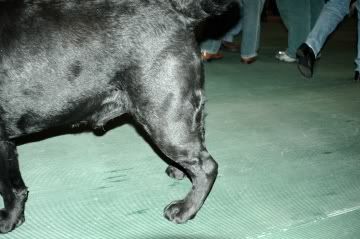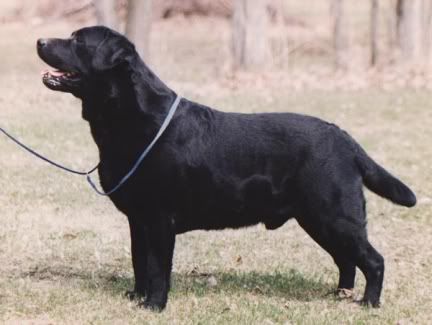

The AKC standard states:
"The Labrador's hindquarters are broad, muscular and well-developed from the hip to the hock with well-turned stifles and strong short hocks. Viewed from the rear, the hind legs are straight and parallel. Viewed from the side, the angulation of the rear legs is in balance with the front. The hind legs are strongly boned, muscled with moderate angulation at the stifle, and powerful, clearly defined thighs. The stifle is strong and there is no slippage of the patellae while in motion or when standing. The hock joints are strong, well let down and do not slip or hyper-extend while in motion or when standing. Angulation of both stifle and hock joint is such as to achieve the optimal balance of drive and traction. When standing the rear toes are only slightly behind the point of the rump. Over angulation produces a sloping topline not typical of the breed. Feet are strong and compact, with well-arched toes and well-developed pads. Cow-hocks, spread hocks, sickle hocks and over-angulation are serious structural defects and are to be faulted."
What this means is that the rear should have a moderate angulation and not be overangulated as one would see with a setter or in the extreme, a German shepherd. The Labrador topline should be straight and not sloping. If there is too much angulation, then the front and rear aren't in balance and there will likely not be the smooth reach and drive that a good moving Labrador should have. A weak rear that has a straight stifle is contrary to the power that is needed in the rear of a Labrador. This breed needs to use its rear to propel through the water as well as handle marsh and upland terrain that is challenging. I personally like to see a strongly muscled and thick second thigh.
I always look at the hock joints and like to see clean hocks. Hock OCD does occur in the breed and can be crippling. The hocks should be well bent but short and strong. The first photo above shows what a sickle hock looks like. The bottom photo (of Can. Ch. Ranbourne This Bud's for You, Tilly's sire) shows what I like to see in a rear.
The rear not only needs to be balanced with the front when viewed from the side but it's important to look at how the hind legs are positioned when viewed from behind the dog. The hind legs should be straight and parallel with good bone and muscle tone. I like to look down the back of the dog from above and see whether the rear is strong and not winnowed.
You can read more about the rear end and other points of the Labradors by looking at the illustrated standard put out by the The Labrador Retriever Club of Canada. The link is http://www.labrador-canada.com/lrccstd.pdf

No comments:
Post a Comment